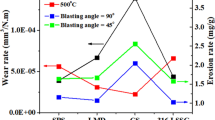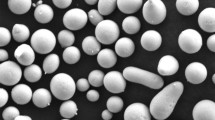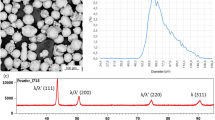Abstract
The present work aimed to assess the effect of post-heat treatment on microstructure and tribological performance of AISI 410 clads processed by laser-directed energy deposition (L-DED) to simulate the repair of ball valve plugs used in the oil and gas industry. The coatings were deposited by L-DED process on AISI 410 substrates using an AISI 410L gas-atomized metallic powder. Coatings in the as-built and heat-treated conditions were characterized in terms of microstructure, hardness, and microabrasive wear performance. For comparison purposes, a ball valve plug of AISI 410 was also characterized. For the L-DED processing conditions used, defect-free AISI 410L coatings were obtained. The post-heat treatment had a significant effect on the microstructure and hardness of the coatings. Despite this, the coatings performance was statistically equal to the ball valve. Therefore, from the point of view of the wear performance, the results indicate that a ball valve of AISI 410 can be satisfactorily repaired by L-DED process without post-heat treatments.












Similar content being viewed by others
Data availability
Not applicable.
References
Moses D, Haider G, Henshaw J (2019) An investigation of the failure of a 1/4” ball valve. Eng Fail Anal 100:393–405. https://doi.org/10.1016/j.engfailanal.2019.02.047
Sotoodeh K (2021) A practical guide to piping and valves for the oil and gas industry. Gulf Professional Publishing
Mnif R, Ben JMC, Elleuch R (2013) Tribological failure analysis of ball valve seals. Int J Microstruct Mater Prop 8:385–396. https://doi.org/10.1504/IJMMP.2013.057074
Stewart M (2016) Surface production operations - facility piping and pipeline systems, 1st edn. Elsevier Science
Bae J, Chung K-H (2016) Wear characteristics of metal ball and seat for metal-seated ball valve. J Korean Soc Tribol Lubr Eng 32:32–37. https://doi.org/10.9725/kstle.2016.32.1.32
Peng D, Dong S, Wang Z et al (2021) Characterization of the solid particle erosion of the sealing surface materials of a ball valve. Metals (Basel) 11:1–19. https://doi.org/10.3390/met11020263
Kadoi K, Murakami A, Shinozaki K et al (2016) Crack repair welding by CMT brazing using low melting point filler wire for long-term used steam turbine cases of Cr-Mo-V cast steels. Mater Sci Eng A 666:11–18. https://doi.org/10.1016/j.msea.2016.04.035
Odhiambo JG, Li WG, Zhao YT, Li CL (2019) Porosity and its significance in plasma-sprayed coatings. Coatings 9:1–19. https://doi.org/10.3390/coatings9070460
Zhu Y, Yang Y, Mu X et al (2019) Study on wear and RCF performance of repaired damage railway wheels: Assessing laser cladding to repair local defects on wheels. Wear 430–431:126–136. https://doi.org/10.1016/j.wear.2019.04.028
Molina C, Araujo A, Bell K et al (2021) Fatigue life of laser additive manufacturing repaired steel component. Eng Fract Mech 241:107417. https://doi.org/10.1016/j.engfracmech.2020.107417
Deev A, Kuznetsov P, Zhukov A, Bobyr V (2017) The Structure and properties of the samples produced by selective laser melting of 410L steel-based metal powder. Phys Proced 89:31–38. https://doi.org/10.1016/j.phpro.2017.08.013
Pacheco JT, da Silva LJ, Barbetta LD et al (2020) Laser cladding of stellite-6 on AISI 316 L austenitic stainless steel: empirical-statistical modeling and parameter optimization. Lasers Manuf Mater Process. https://doi.org/10.1007/s40516-020-00132-0
Rutherford KL, Hutchings IM (1996) A micro-abrasive wear test, with particular application to coated systems. Surf Coat Technol 79:231–239. https://doi.org/10.1016/0257-8972(95)02461-1
Ardila MAN, Costa HL, De MJDB (2020) Influence of the ball material on friction and wear in microabrasion tests. Wear. https://doi.org/10.1016/j.wear.2020.203266
Lai Q, Abrahams R, Yan W et al (2018) Effects of preheating and carbon dilution on material characteristics of laser-cladded hypereutectoid rail steels. Mater Sci Eng A 712:548–563. https://doi.org/10.1016/j.msea.2017.12.003
Mabruri E, Prifiharni S, Anwar MS et al (2018) Mechanical properties optimization of the modified 410 martensitic stainless steel by heat treatment process. Mater Today Proc 5:14918–14922. https://doi.org/10.1016/j.matpr.2018.04.030
Zhu H, Ouyang M, Hu J et al (2021) Design and development of TiC-reinforced 410 martensitic stainless steel coatings fabricated by laser cladding. Ceram Int 47:12505–12513. https://doi.org/10.1016/j.ceramint.2021.01.108
Köse C, Topal C (2019) Effect of post weld heat treatment and heat input on the microstructure and mechanical properties of plasma arc welded AISI 410S ferritic stainless steel. Mater Res Express 6:13. https://doi.org/10.1088/2053-1591/ab09b6
Zhang D, Niu W, Cao X, Liu Z (2015) Effect of standard heat treatment on the microstructure and mechanical properties of selective laser melting manufactured Inconel 718 superalloy. Mater Sci Eng A 644:32–40. https://doi.org/10.1016/j.msea.2015.06.021
Vashishtha N, Sapate SG, Bagde P, Rathod AB (2018) Effect of heat treatment on friction and abrasive wear behaviour of WC-12Co and Cr3C2-25NiCr coatings. Tribol Int 118:381–399. https://doi.org/10.1016/j.triboint.2017.10.017
Acknowledgements
The authors would like to thank the SENAI Institute of Innovation in Manufacturing Systems and Laser Processing, for making the infrastructure available and their support in conducting this research, along with the National Council for Scientific and Technological Development (CNPq) and Santa Catarina University Scholarship Program (UNIEDU). The authors would also like to thank Santa Catarina State University (UDESC) for their support during the development of this work.
Author information
Authors and Affiliations
Corresponding author
Ethics declarations
Conflict of interest
The authors declare that there is no conflict of interest.
Additional information
Publisher's Note
Springer Nature remains neutral with regard to jurisdictional claims in published maps and institutional affiliations.
Rights and permissions
Springer Nature or its licensor (e.g. a society or other partner) holds exclusive rights to this article under a publishing agreement with the author(s) or other rightsholder(s); author self-archiving of the accepted manuscript version of this article is solely governed by the terms of such publishing agreement and applicable law.
About this article
Cite this article
Meura, V.H., Pacheco, J.T., Veiga, M.T. et al. Effect of post-heat treatment on microstructure and tribological performance of AISI 410L coatings processed by laser-directed energy deposition (L-DED). Prog Addit Manuf 8, 1367–1377 (2023). https://doi.org/10.1007/s40964-023-00404-z
Received:
Accepted:
Published:
Issue Date:
DOI: https://doi.org/10.1007/s40964-023-00404-z




